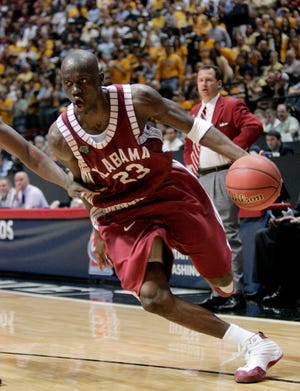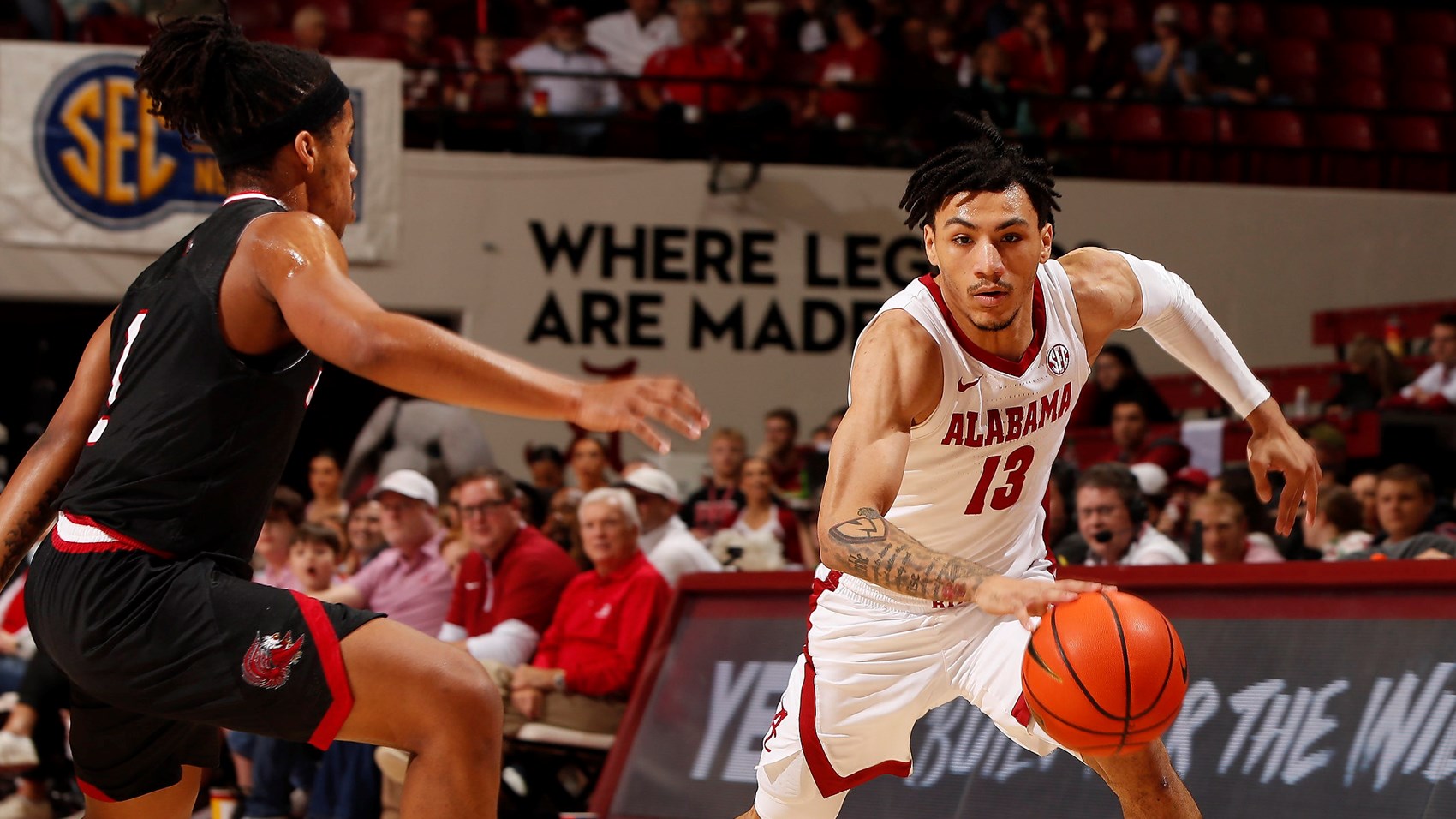NCAA Tournament Preview No.5 SDSU vs No.1 Alabama

Credit: Smith Seckman Reid, Inc.

Path to the NCAA Tournament
Alabama entered the NCAA Tournament as the number one overall seed and, through two games, has lived up to that billing. It led the entire contest in its opening game win over No.16 Texas A&M Corpus Christi. The Crimson Tide got the first nine points of the game, built a 20-point halftime lead, and cruised to a 96-75 victory.
The University of Maryland matched up against Alabama in the Round of 32. The SEC regular season and tournament champions had as much trouble dispatching the traditional ACC power in the second round as they did the Southland Tournament champs in the Round of 64. The Crimson Tide led by five at the half before racing to a 22-point (73-51) win. Maryland’s 51 points were its third-lowest total of the year.
San Diego State will be playing in its third Sweet 16 in program history thanks to victories over two double-digit seeds. Up first for the Red and Black was the College of Charleston. Fighting nerves at the beginning of the contest, the Aztecs composed themselves down the stretch to dispatch the Cougars 63-57.
Two games after defeating the No. 4 seed, Furman eyed another upset. SDSU had other intentions and played one of its most complete games of the year on its way to a dominating 75-52 win. In both contests, the Aztecs’ physicality shined through. They proved to the nation what they had always believed about themselves.
“No,” SDSU head coach Brian Dutcher responded last Saturday after his team arrived on campus when asked if his team feels any vindication for reaching the Sweet 16. “We’ve known we were good. It’s hard to win a basketball game. We just keep grinding every day. We try to win the next game in front of us. We don’t obsess over what’s ahead of us. We try to get better every day, and if we get better every day, we’ll have a chance to win games.”
Previous Meeting
Friday will be the first meeting between the schools, but there is some basketball history between the institutions. On March 16, 2006, Alabama and Marquette played in the highest-scoring NCAA Tournament game in Viejas Arena history. The Crimson Tide won a thrilling 90-85 contest over the Golden Eagles.

Showing how unpredictable single-elimination games can be, Alabama was led by forward Jean Felix. Felix scored 31 points. He hit eight three-pointers, which is an arena record in an NCAA game. The eight makes were four more than he had in any other game over his two-year career with Crimson Tide. The game was marred by a bomb scare. The arena was emptied for 70 minutes prior to warmups before first responders gave the all-clear.
“They were joking in the back of the bus, ‘The bomb’s not going to beat us, coach,'” Alabama’s Mark Gottfried said at the time. “It throws you off a little bit, but the important thing’s to make sure the building is safe.”
SDSU is 3-10 all-time against SEC teams, including a 78-74 overtime loss to Arkansas in November. Alabama defeated the Razorbacks twice in the regular season.
Scouting Report
Alabama is the top seed in the tournament for a reason. They are talented, deep and are one of the few teams that is taller than the Aztecs. Ten players have played in 25 or more contests, and nine played in 30 plus. Against Maryland, however, head coach Nate Oats relied heavily on his starters. Only two players off the bench played double-digit minutes, and none had more than 11.
The name of the game for Alabama is to force teams to take and make mid-range jumpers while limiting its own attempts from that range. The Crimson Tide shoot a lot of threes and get to the rim frequently but do not put up a lot in between. On defense, they drop their center into the lane on the pick and roll to force long jumpers and allow the rest of the defenders to stay close to perimeter defenders.
“Yeah, (SDSU’s point guards) are going to have to settle for mid-range jump shots at times,” Dutcher explained on Tuesday. “Sometimes, we duck in the opposition’s post player where there’s clear lanes to the basket because we play efficient in the low post. It’s just making the right reads. I can’t tell them what that’s going to be. I can’t go to game prep and say, ‘do this every time; it’s going to be there.’ It’s not going to be there every time, so it’s about players making important plays, reading the defense, making the correct play that usually will win basketball games.”
Player to Watch: Jahvon Quinerly
For all of Alabama’s stats and trends over the year, the Crimson Tide are a two-headed monster offensively right now. National Freshman of the Year Brandon Miller and senior Jahvon Quinerly have taken the majority of the team’s shots over the last month. The rest of the team is orbiting around them.
Nearly one year ago, Quinerly suffered a torn ACL at Viejas Arena. Less than four minutes into the Crimson Tides’ first NCAA Tournament game, Quinerly fell in pain on Steve Fisher Court. Without the injury, he likely would not be playing in Friday’s contest against the Aztecs.

Quinerly beat all rehab predictions and played in the fourth game of Alabama’s season. Throughout the year, Oats slowly built up his minutes. Off the bench, Quinerly averaged 17.3 minutes per game over the first 27 games. Beginning on February 25 against Arkansas, Quinerly’s role changed dramatically.
He averaged 30.25 minutes over the last eight games while starting for Alabama in the last four. Quinerly has been the Crimson Tide’s second-best player over the eight-game stretch. Including an 0-9, one-point outing against Missouri, he is shooting 48.8% (40-82) from the field and 37.8% (14-37) from three while averaging 15 points and 3.4 assists.
Teams change how they play when their season is on the line. Miller and Quinerly have taken the lion’s share of shot attempts in close elimination games. Against Maryland in the Round of 32 and in the SEC Tournament title game, they were the only players with double-digit attempts. Together, they combined for more than half of the Crimson Tide’s shots in those contests.
Miller cannot beat the Aztecs on his own. He will need help. Against the Terps, the only other player to rise to the occasion was Quinerly. Putting the clamps on him could go a long way to delivering an Aztec win.
“Usually, (players) determine who plays and who doesn’t play,” Dutcher said, explaining how coaches decide their rotations. “There’s not a coach alive who is not going to play a productive lineup. Sometimes you play a lot of guys early in the year, and some guys are so much better that you start cutting your numbers and cutting them way down in important games.”
“But, right now, there are games where our bench is better than our starting lineup. Sometimes we play better with our bench in the game. It all depends on who is playing well on what particular night is who we go with. That’s been our strength all year is our depth, so hopefully, that will continue to pay dividends when we play Friday night against Alabama.”
Key to the Game: Scoring Easy Baskets
The team that has the decided advantage on easy baskets will likely head to the Elite Eight. They can come in a variety of ways. Offensive rebounds steals that lead to transition offense, lapses in defensive assignments, or even bad shot attempts that bank into the basket.

Alabama plays with great tempo, and the Aztecs are going to need to slow the pace in order to compete, but they will also have to selectively find times to push the ball when it is to their advantage. SDSU won’t be able to run with the Crimson Tide for forty minutes, but they should be able to do that for important stretches.
Alabama is good on the offensive glass, averaging nearly 13 per contest. They also give up a lot. Only nine times all year have they prevented their opponents from reaching double digits in offensive rebounds. Maximizing this strength for the Aztecs could mitigate the fast break threat Alabama poses in that area.
“We’ve been opportunistic (but) we haven’t been the running team I want to be,” Dutcher explained. “That’s the hardest thing to do is to run all the time, and very few schools are able to accomplish that. We’re a good running team; we’re not a great running team. Obviously, we don’t want them getting out on the break, so we’re not going to race them to 100 points, but we want to make them try to play a half-court game. It is easier said than done because they really rebound the ball, they have great athletes, and they get out and run. We’ve got to try and slow that down the best we can.”
My earliest sport’s memory involve tailgating at the Murph, running down the circular exit ramps, and seeing the Padres, Chargers and Aztecs play. As a second generation Aztec, I am passionate about all things SDSU. Other interests include raising my four children, being a great husband and teaching high school.